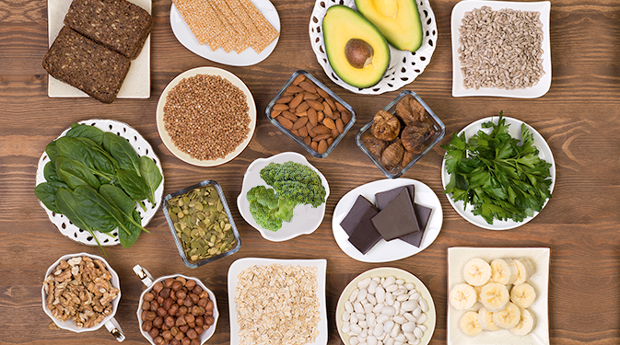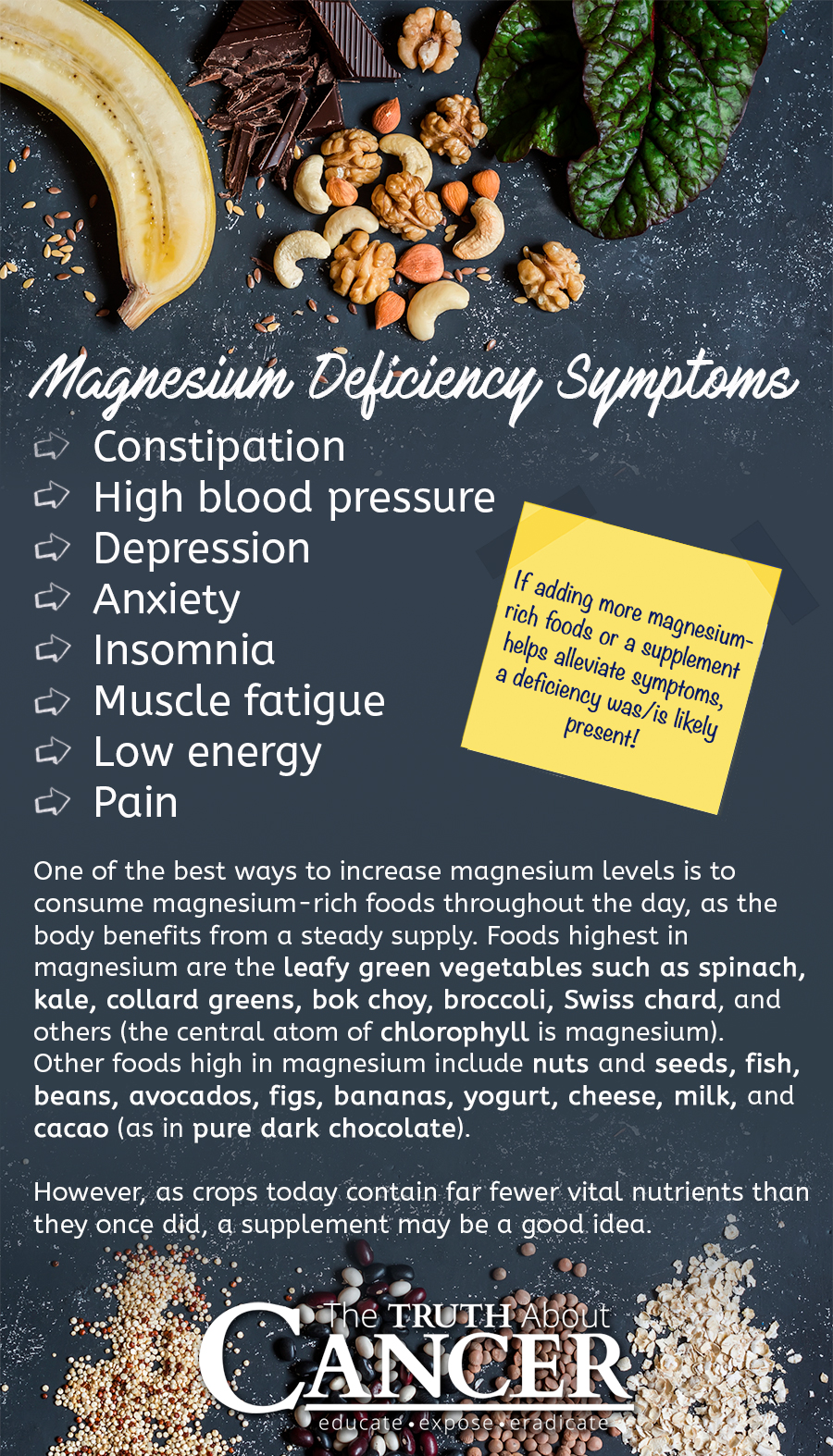Magnesium is essential for health and is necessary for over a thousand enzymatic reactions in the body. It’s needed for DNA replication and repair, controlling inflammation, and for cell proliferation. It is also crucial for detoxification as well as Vitamin D synthesis. Yet dietary surveys of Americans consistently show that intakes of magnesium are lower than recommended amounts.
A magnesium deficiency increases cell membrane permeability allowing viruses, fungi, and heavy metals such as aluminum, mercury, lead, and cadmium to enter cells, potentially triggering carcinogenesis (cancer formation). Plus, low magnesium inhibits the synthesis of glutathione – the master antioxidant, thus leading to an increase in free radical generation.
The Government Recommended Dietary Allowance (RDA) for magnesium is 320 mg for women over 30, and 420 mg for men over 30. However actual requirements will vary for each individual, and most knowledgeable, nutritionally-oriented experts agree that the average adult needs around 400 mg – 1,000 mg per day of magnesium.
How to Best Increase Your Magnesium Levels
One of the best ways to increase magnesium levels is to consume magnesium-rich foods throughout the day, as the body benefits from a steady supply. Foods highest in magnesium are the leafy green vegetables such as spinach, kale, collard greens, bok choy, broccoli, Swiss chard, and others (the central atom of chlorophyll is magnesium). Other foods high in magnesium include nuts and seeds, fish, beans, avocados, figs, bananas, yogurt, cheese, milk, and cacao (as in pure dark chocolate).
However, as crops today contain far fewer vital nutrients than they once did, a supplement may be a good idea.
Cancer Patients Are Often Deficient in Magnesium
Patients receiving chemotherapy are at high risk of magnesium deficiency as they often suffer from vomiting and diarrhea, which can deplete magnesium levels. Plus, several chemotherapy drugs, such as Cisplatin, lower magnesium levels. Given that magnesium is needed for vitamin D synthesis, and vitamin D is critical for the prevention and treatment of cancer, a magnesium deficiency can impede or prevent healing.
The standard test for deficiency is a serum magnesium test, but unfortunately this test is not reliable – one can be in the “normal” range and not be at all normal. The problem is that 90% or more of magnesium is not in the blood, but rather inside cells, so a blood test will not yield much information. Don’t expect your mainstream doctor to know this.
There are a few other tests available, but none appear to be accurate. It would likely be more effective to pay attention to magnesium deficiency symptoms, such as constipation, high blood pressure, depression, anxiety, insomnia, muscle fatigue, low energy, pain, and even cancer to name a few. If adding more magnesium-rich foods or a supplement helps alleviate symptoms, a deficiency was/is likely present.
Magnesium Supplementation Options
- Magnesium glycinate (least likely to cause diarrhea)
- Magnesium citrate (mild laxative effects)
- Magnesium carbonate (good for those with acid reflux)
Magnesium citrate and carbonate are available in powdered form (a good option for those who don’t like to swallow pills). Magnesium chloride is great transdermally, meaning you apply it to your skin. Magnesium oil, as it is often called, usually comes in a spray bottle as well as in the thicker gel form. Absorption will vary, but dosage is 1 to 2 teaspoons daily. Magnesium flakes and magnesium sulfate − known as Epsom salt − can be added to a bath.
Many people over the age of 50 have low hydrochloric acid levels in their stomach and impaired digestion. Obtaining magnesium transdermally (using the oil, gel, or in a bath) can get it directly into cells and the bloodstream and circulating throughout the body. Many well-informed doctors and health practitioners believe that this is one of the best ways to ensure adequate magnesium intake and to achieve healthy intracellular magnesium levels.
Since magnesium can have a laxative effect, absorbing magnesium through the skin also helps to avoid magnesium deficiency induced by too much magnesium.
Can Taking Too Much Magnesium Induce Magnesium Deficiency?
Because ingesting magnesium can have a laxative effect, taking too much magnesium for your body can cause magnesium deficiency through what is called gastrointestinal hurry. This is when digestive transit time increases to the point where absorption of nutrients becomes compromised.
To measure your own transit time (the length of time food takes in the gastrointestinal tract to go from mouth to anus), simply do not take any magnesium for a few days. By consuming an adequate amount of corn (organic and non-GMO of course), beets, or charcoal tablets, observe how long any of these take to emerge. (By the way, a normal transit time is about 12 hours to 24 hours).
Start by taking 100 mg of magnesium and see if your transit time increases. Increase your daily dose 50 mg at a time until you notice a difference and then back off. It’s important to note that spacing out your magnesium dosage throughout the day, say three times a day with meals and then before bed, lessens the likelihood of creating a situation that could induce a deficiency.
According to Jonathan Wright, MD, most people can take between 200 mg and 600 mg of magnesium each day without risking gastrointestinal hurry or magnesium-induced nutrient deficiency. Keep in mind though that it can happen at doses lower than 200 mg. If this is of any concern, you can combine a small amount, say 200 mg, of magnesium orally spaced throughout the day and use magnesium transdermally with oil, gel, or a bath. The other option of course is to just use magnesium transdermally.
Want to stay abreast of new ways to stay healthy? Be notified each week when cutting-edge articles are added by clicking here. You’ll be glad you did.
Article Summary
Magnesium is essential for health and is necessary for over a thousand enzymatic reactions in the body.
One of the best ways to increase magnesium levels is to consume magnesium-rich foods throughout the day.
Foods highest in magnesium are the leafy green vegetables such as spinach, kale, collard greens, bok choy, broccoli, and Swiss chard.
Other foods high in magnesium include nuts and seeds, fish, beans, avocados, figs, bananas, yogurt, cheese, milk, and cacao.
Patients receiving chemotherapy are at high risk of magnesium deficiency.
Magnesium Supplementation Options:
- Magnesium glycinate (least likely to cause diarrhea)
- Magnesium citrate (mild laxative effects)
- Magnesium carbonate (good for those with acid reflux)
Taking too much magnesium for your body can cause magnesium deficiency.





















I get my magnesium by daily munching edible plants that grow in the yard and nearby fields. The chlorophyll molecule is built around the magnesium atom, like hemoglobin is built around iron. There’s a huge amount of flora that’s edible straight from nature. About a third of it.
We do that all spring,summer and automn,but as winter gets rather harsh,all leafy greens die,so we buy organic local salads… And I wonder if our sprouts,in jars or sprouters,are any good for supplying magnesium…
What about Magnesium Malate?
Pure magnesium, also known as elemental magnesium, is highly reactive and flammable. Combining magnesium with another chemical, typically a salt compound such as citrate or malate, creates a more stable molecule that can be ingested as a health supplement. The different salt forms of magnesium have slightly different properties and are often used for different purposes.
Magnesium citrate is the product of magnesium combined with citric acid, which has the chemical formula C6H6O7Mg. Magnesium citrate is often used in liquid form as a saline laxative to treat constipation, or to completely empty the intestines prior to surgery, explains the University of Maryland Medical Center. Magnesium citrate may also be packaged into capsules and used to increase levels of magnesium in the blood to treat magnesium deficiency.
Magnesium malate forms when magnesium is reacted with malic acid, yielding a chemical with the formula C4H4MgO5. Magnesium malate is most commonly used to treat a condition known as fibromyalgia, according to the University of Mary Washington. Fibromyalgia is a poorly understood disease characterized by fatigue, muscle pain, stiffness, headache and memory problems, and may be linked to low magnesium levels.
I get my magnesium by eating a whole banana for breakfast every day and eating fish quite often.
Doesn’t eating all that fish put you at risk for mercury poisoning?
I take Neurotin before breakfast and before bed along with supplements. Now I read that I cannot take magnesium at the same time before breakfast and before bedtime since the magnesium interferes with the Neurotin. I can take magnesium between lunch and dinner but that is one dose of 500 mgs. Can I take magnesium at each meal? Thank you for any help.
Oh there are so many ways to go…on the cansurviving site we collect the best and add to it for our international free group – no two people are the same, you can choose your OWN way….cansurvivors unite…and it involves the mind and the spirit too don’t forget…
Oh there are so many ways to go…on the cansurviving site we collect the best and add to it for our international free group – no two people are the same, you can choose your OWN way….cansurvivors unite…and it involves the mind and the spirit too don’t forget…
i cant sleep a night of regular sleep unless i take my magnesium supplement (i use natural calm magnesium). i will get insomnia guaranteed if i dont take magnesium, no matter how much raw organic cacao or healthy foods i eat, i still need the supplement to sleep. dont know why im so deficient, maybe because im breastfeeding, but its been a couple years now, and magesium saved my life (among other dietary things, gluten free, etc)! it also is effective in helping to prevent migraines. highly recommend everyone try this supplement no matter how healthy they eat. i cant live without it and my diet is very very clean and real food.
You sound like a commercial. All that’s missing is a link.